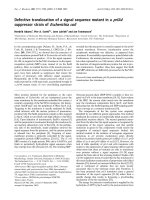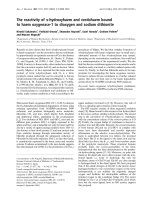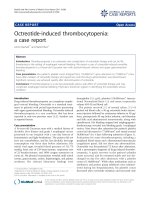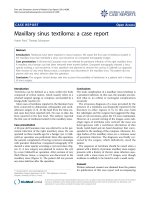Báo cáo y học: "Late presentation of a mucinous ovarian adenocarcinoma which was initially diagnosed as a primary pancreatic carcinoma: a case report and review of the literature" ppsx
Bạn đang xem bản rút gọn của tài liệu. Xem và tải ngay bản đầy đủ của tài liệu tại đây (624.86 KB, 4 trang )
CAS E REP O R T Open Access
Reduced uptake of the proliferation-seeking
radiotracer technetium-99m-labelled pentavalent
dimercaptosuccinic acid in a 47-year-old woman
with severe breast epithelial hyperplasia taking
ibuprofen: a case report
Vassilios J Papantoniou
1*
, Evangelia K Sotiropoulou
2
, Pipitsa N Valsamaki
1
, Angeliki G Tsaroucha
1
,
Maria G Sotiropoulou
3
, Nikolaos D Ptohis
4
, Aikaterini J Stipsanelli
1
, Konstantinos E Dimitrakakis
5
,
Spyridon G Marinopoulos
5
, Spyridon T Tsiouris
1
, Aris J Antsaklis
5
Abstract
Introduction: Recent studies have reported a risk reduction in the progression of benign breast disease to breast
carcinoma through COX-2 pathways.
Case presentation: We present a case of sev ere epithelial hyperplasia in a 47-year-old woman with increased
breast density submitted to scintimammography by the proliferation-imaging tracer Technetium-99m-labelled
pentavalent dimercaptosuccinic acid, before and after an oral ibuprofen treatment for 4 weeks. The radiotracer
uptake after ibuprofen intake was significantly reduced, both visually and by semi-quantitative analysis, based on a
calculation of lesion-to-background ratios.
Conclusion: In proliferating breast lesions, scintigraphically displayed reduction in Technetium-99m-labelled
pentavalent dimercaptosuccinic acid uptake may indicate inhibition by ibuprofen in the pathway of malignant
epithelial cell transformation.
Introduction
Several epidemiological and laboratory studies suggest
that non-steroidal anti-inflammatory drugs (NSAIDs)
may have chemo-preventive effects in breast cancer,
owing to their activity against cyclo-oxygenase-2
(COX-2), the rate-limiting enzyme in the prostaglandin
cascade [1]. Recent studies have suggested that inflam-
mation through COX-2 pathways may play a role in
the progression of benign breast disease to breast car-
cinoma, and that aspirin may reduce this risk in
women with s imilar lesions [2]. Significant reductions
in the risk of malignant transformation have been
reported with selective COX-2 inhibi tors, as well as
with over-the-counter non-steroidal anti-inflammatory
drugs, including ibuprofen and naproxen [1].
Another important related consideration is the postu-
lated association between benign proliferating breast
disease, mammographic density, and subsequent malig-
nant transformation [2-4]. Technetium-
99m
-labelled
pentavalent dimercaptosuccinic acid (
99m
Tc-(V)DMSA)
is a tumor-seeking radiotracer. Its relationship to focal
adhesion kinase (FAK) activation and cellular prolifer-
ating activity has been described i n previous reports
not only for invasive but also for pre-invasive and
benign proliferating breast lesions [5-8]. This case
report was undertaken to investigate whether a reduced
rate of cellular pro liferation, mediated by ibuprofen as
described in previous retrospective studies, could be
visualized by alterations in the patient’ s
99m
Tc-(V)
DMSA uptake ratio.
* Correspondence:
1
Department of Nuclear Medicine, Alexandra University Hospital, Vasilissis
Sofias Avenue, Athens, 11528, Greece
Papantoniou et al. Journal of Medical Case Reports 2010, 4:89
/>JOURNAL OF MEDICAL
CASE REPORTS
© 2010 Papanton iou et al; licensee BioMed Central Ltd. This is an Open Access article distributed under the terms of the Creative
Commons Attribution Lice nse ( which permits unrestricted use, distribution, and
reproduction in any medium, provided the original work is pro perly cited.
Case presentation
A 47-year-old Caucasian woman of Greek national ori-
gin was referred to our department with a mammogram
showing increased breast density with multiple dispersed
nodular opacities, linear opacities, periareolar fibrosis,
and microcalcifications in the lower outer quadrant of
her right breast. Histology of an open biopsy specimen
(Figure 1) showed foci of severe epithelial hyperplasia,
areas of calcification, and apocrine metaplasia. Scinti-
mammography with
99m
Tc-(V)DMSA was performed
2 days before the scheduled biopsy and then 7 months
later. Within 4 weeks before the follow-up study, our
patient took oral ibuprofen (400 mg daily) for persistent
musculoskeletal back pain.
After intravenous administration o f 925MBq of the
tracer, early and late planar (lateral prone and anterior
supine) images were acquired at 10 minute an d 60 min-
ute after injection. Breast
99m
Tc-(V)DMSA uptake in the
early and late images was evaluated visually. Quantita-
tive comparisons between the 10 minute and 60 minute
scans and between the baseline study before biopsy and
after the course of ibuprofen were performed by draw-
ing regions of interest (ROIs) over the breast sites of
greatest tracer uptake and over the normal breast par-
enchyma. The lesion-to-background (L/B) ratios were
then calculated and compared between the same corre-
sponding breast areas in the two scintigraphic studies.
A pattern of diffuse widespread tracer uptake corre-
sponding to pre-invasive breast pathology (epithelial
hyperplasia and in situ carcinoma, according to our pre-
vious reports [5,8]), was also ob served in this case
(Figure 2). This diffuse
99m
Tc-(V)DMSA distribution
almost entirely occupied our patient’s right breast par-
enchyma and was evident in the images both before
(Figures 2A and 2B) and after her ibuprofen treatment
(Figures 2C and 2D). There was a gradual increase i n
the relative uptake of the tracer on the delayed images,
compared with the early ones. However, after her ibu-
profen treatment, diffuse tracer uptake was clearly
diminished in both the early (Figure 2C) and late (Figure
2D) images. The L/B ratios in the 1 0 minute and
60 minute images were 1.562 and 2.719 (Figure 2A and
2B, respectively) in the baseline study versus 1.229 and
1.993 (Figure 2C and 2D, respectively) at follow-up
examination. Based on our recent study, women without
epithelial hyperplasia or with usual ductal breast hyper-
plasia without increased cellular proliferation rate (Ki-67
≤ 3%) show
99m
Tc-(V)DMSA L/B
60 min
ratios in the
rangeof1.07to1.31(mean=1.15)and0.77to1.62
(mean = 1.2), respectively (5).
Discussion
Our key finding is that a short period of ibuprofen treat-
ment resulted in a 27% reduction in the uptake of
99m
Tc-(V)DMSA in a case of proliferative benign epithe-
lia l breast hyperplasia. Other recent studies have shown
that COX-2 inhibitors may reduce the risk of breast
cancer [1]. Spec ifically, a retrospective study of almost
1000 women showed that a selective COX-2 inhibitor,
celecoxib 200 mg/day for at least two years, reduced the
risk of breast cancer by 83%, while rofecoxib 25 mg/day
reduced the risk by 64% [1]. The non-selective COX
inhibitors aspirin and ibuprofen and/or naproxen gave a
reduced odds ratio (0.49 and 0.37, respectively, with
95% confidence intervals) for the incidence of breast
Figure 1 Extensive severe ductal epithelial hyperplasia of usual
type and apocrine metaplasia (Hematoxylin and Eosin staining,
×100).
Figure 2 Images of (A) early pre-ibuprofen, (B) late pre-
ibuprofen (C) early post-ibuprofen, and (D) late post-
ibuprofen treatment of
99 m
Tc-(V)DMSA distribution. After
ibuprofen treatment, the diffuse tracer uptake is clearly diminished
in both early (C) and late imaging (D).
Papantoniou et al. Journal of Medical Case Reports 2010, 4:89
/>Page 2 of 4
cancer compared with non-use. Moreover, the odds
ratio for breast cancer by dose and frequency was
0.28 for ibuprofen 200 mg more than 3 t imes weekly.
In this context, other investigators have suggested that
inflammation mediated through COX-2 pathways may
play a role in t he progression of benign breast disease
to carcinoma, and that aspirin may reduce such risk in
women with benign breast disease [2].
99m
Tc-(V)DMSA is a tumor-seeking tracer whose cel-
lular uptake is linked to FAK activati on and cell prolif-
eration, which is a precocious stage of malignant
transformation [6,7,9]. Compared with invasive lesions,
the exact mechanism of
99m
Tc-(V)DMSA accumulation
in benign proliferating diseases and in some non-prolif-
erating diseases with higher L/B ratios is not yet clear
[5,7].Giventhatbenignproliferating diseases generally
have lower proliferation rate than invasive cancers, this
raises the suspicion that
99m
Tc-(V)DMSA reflects an
earlier cell activation status of phosphorylated FAK in
the process of increasing the rate of cell proliferation
[5,6,8]. Hence, in our case, the reduction in diffuse
99m
Tc-(V)DMSA uptake after a relatively short period
(4 weeks) of ibuprofen treatment may indicate a “switch
off” mechanism on activat ed FAK, rather than a slowing
down of the proliferation rate. Although we have pro-
vided no biopsy confirmation after treatment, ibuprofen
was the only treatment that our patient took between
her scintimammographic studies. The biokinetic charac-
terist ics of
99m
Tc-(V)DMSA support our suggestion that
the o bserved reduction in its uptake was attributable to
ibuprofen-induced cyclo-oxygenase COX inhibition.
Conclusion
Our research so far has shown that diffuse tracer uptake
during
99m
Tc-(V)DMSA scintimammography can be
considered indicative of an underlying proliferative
hyperplastic or in situ path ology. This report focuses on
a patient with severe breast epithelial hyperplasia
enrolled in a current prospective study. In another
recent report on hyperplastic lesions [10], we studied
the i maging properties and biokinetic characteristics of
99m
Tc-(V)DMSA in relation to mammographic density.
As long as these lesions can be visualized, it would be of
great clinical interest if we could e stimate the effective-
ness of various chemopreventive agents by quantifying
their effect on
99m
Tc-(V)DMSA uptake.
Consent
Written informed consent was obtained from the patient
for publication of this case report and any accompany-
ing images. A copy of the written consent is available
for review by the Editor-in-Chief of this journal.
Acknowledgements
We recognize with appreciation Dr. Lyra Stavroula for providing valuable
support to the radiologic investigation.
Author details
1
Department of Nuclear Medicine, Alexandra University Hospital, Vasilissis
Sofias Avenue, Athens, 11528, Greece.
2
Department of Radiology, Sotiria
General Hospital, Mesogeion Avenue, Athens, 11527, Greece.
3
Department of
Pathology, Alexandra University Hospital, Vasilissis Sofias Avenue, Athens,
11528, Greece.
4
Department of Radiology, Alexandra University Hospital,
Vasilissis Sofias Avenue, Athens, 11528, Greece.
5
Department of Gynaecology
and Obstetrics, Alexandra University Hospital, Vasilissis Sofias Avenue, Athens,
11528, Greece.
Authors’ contributions
VP conceptualized the case report, contributed substantially to the
organization of the performance of the relevant scintiscans described in this
report, and wrote parts of the manuscript. All of the authors cooperated in
the patient’s care and participated actively in writing the manuscript. ES and
NP performed and analyzed the patient’s mammographic examination. PV,
AT, AS and ST conducted and evaluated the scintimammographic studies.
MS provided the histologic evidence. KD, SM and AA were the clinicians
who followed-up the patient and referred her for further investigation. All
authors read and approved the final manuscript.
Competing interests
The authors declare that they have no competing interests.
Received: 21 October 2009 Accepted: 17 March 2010
Published: 17 March 2010
References
1. Harris RE, Beebe-Donk J, Alshafie GA: Reduction in the risk of human
breast cancer by selective cyclooxygenase-2 (COX-2) inhibitors. BMC
Cancer 2006, 6:27.
2. Gallicchio L, McSorley MA, Newschaffer CJ, Thuita LW, Huang HY,
Hoffman SC, Helzlsouer KJ: Non-steroidal anti-inflammatory drugs,
cyclooxygenase polymorphisms, and the risk of developing breast
carcinoma among women with benign breast disease. Cancer 2006,
106:1443-1452.
3. Friedenreich C, Bryant H, Alexander F, Hugh J, Danyluk J, Page D: Risk
factors for benign proliferative breast disease. Int J Epidemiol 2000,
29:637-644.
4. Ashbeck EL, Rosenberg RD, Stauber PM, Key CR: Benign breast biopsy
diagnosis and subsequent risk of breast cancer. Cancer Epidemiol
Biomarkers Prev 2007, 16:467-472.
5. Papantoniou V, Tsiouris S, Koutsikos J, Sotiropoulou M, Mainta E, Lazaris D,
Valsamaki P, Melissinou M, Zerva C, Antsaklis A: Scintimammographic
detection of usual ductal breast hyperplasia with increased proliferation
rate at risk for malignancy. Nucl Med Commun 2006, 27:911-917.
6. Denoyer D, Perek N, Le Jeune N, Cornillon J, Dubois F: Correlation
between
99 m
Tc-(V)-DMSA uptake and constitutive level of
phosphorylated focal adhesion kinase in an in vitro model of cancer cell
lines. Cancer Biother Radiopharm 2005, 20:249-259.
7. Papantoniou VJ, Souvatzoglou MA, Valotassiou VJ, Louvrou AN, Ambela C,
Koutsikos J, Lazaris D, Christodoulidou JK, Sotiropoulou MG, Melissinou MJ,
Perperoglou A, Tsiouris S, Zerva CJ: Relationship of cell proliferation
(Ki-67) to
99 m
Tc-(V)DMSA uptake in breast cancer. Breast Cancer Res
2004, 6:R56-R62.
8. Papantoniou V, Tsiouris S, Mainta E, Valotassiou V, Souvatzoglou M,
Sotiropoulou M, Nakopoulou L, Lazaris D, Louvrou A, Melissinou M,
Tzannetaki A, Pirmettis I, Koutsikos J, Zerva C: Imaging in situ breast
carcinoma (with or without an invasive component) with technetium-
99m pentavalent dimercaptosuccinic acid and technetium-99m
2-methoxy isobutyl isonitrile scintimammography. Breast Cancer Res
2005, 7:R33-R45.
9. Al-Saeedi F: Role of
99 m
Tc-(V)DMSA in detecting tumor cell proliferation.
Anal Chem Insights 2007, 2:81-83.
Papantoniou et al. Journal of Medical Case Reports 2010, 4:89
/>Page 3 of 4
10. Papantoniou V, Sotiropoulou E, Tsiouris S, Ptohis N, Sotiropoulou M,
Tsigris A, Stipsanelli A, Sirgiannis K, Dimitrakakis K, Valsamaki P, Kounadi E,
Makris N, Zerva C, Antsaklis A: Correlation of mammographic density with
the mode of scintimammographic
99 m
Tc-(V)DMSA uptake in various
breast pathologies [abstract]. EJNMMI 2007, 34:s306.
doi:10.1186/1752-1947-4-89
Cite this article as: Papantoniou et al.: Reduced uptake of the
proliferation-seeking radiotracer technetium-99m-labelled pentavalent
dimercaptosuccinic acid in a 47-year-old woman with severe breast
epithelial hyperplasia taking ibuprofen: a case report. Journal of Medical
Case Reports 2010 4:89.
Submit your next manuscript to BioMed Central
and take full advantage of:
• Convenient online submission
• Thorough peer review
• No space constraints or color figure charges
• Immediate publication on acceptance
• Inclusion in PubMed, CAS, Scopus and Google Scholar
• Research which is freely available for redistribution
Submit your manuscript at
www.biomedcentral.com/submit
Papantoniou et al. Journal of Medical Case Reports 2010, 4:89
/>Page 4 of 4









